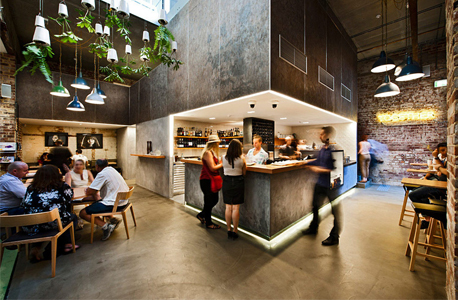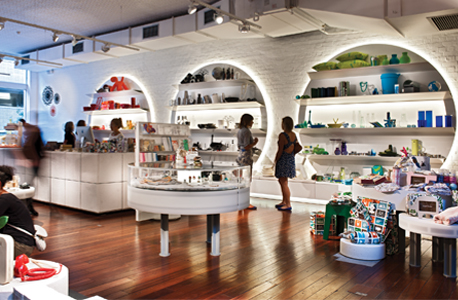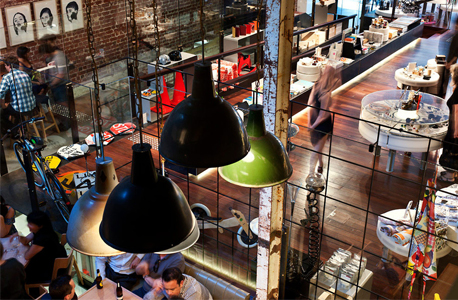
The Geyer balance
Share
Above—JTW head office in Sydney, 2014. Photography Luc Remond. Article by Gillian Serisier.
It is often said that how you begin is how you continue and nothing could be truer of Geyer. Having commenced 30 years ago as a partnership between Peter and Sandy Geyer, the practice has a core culture that remains one of equality and the strength borne of partnership. With some of the biggest projects to its name and global leaders including BHPB (Billiton), Westpac Group and Telstra among its clients, Geyer has successfully transitioned to become the largest stand-alone interior design company in Australia.
The evolution of Geyer is largely due to the combined attributes of flexibility and insight. Renowned for bringing these qualities to its projects, Geyer’s thinking behind each project has been radically expanded to include agility, flexibility, technology and the human condition. This is also true of the manner in which the practice operates, manifested in a shift in the way teams of designers are created that is far more flexible. Global design leader for Geyer, Simone Oliver, explains: “It is no longer an architecturally driven design outcome based on pure aesthetics. Clients are embracing the way in which communities thrive through the power of space, technology and desired behaviours.”
Having been with Geyer on and off for the past 20 years, Oliver is in a unique position to analyse this shift. “Clients are taking far greater interest in the human experience of environments and how that might be affecting their culture in terms of creativity, well-being and individual happiness for their people,” she says, “whether it’s a retail, education, hospitality or workplace scenario.” As such, the partnering of teams to leverage a unique skill set is paramount to ensuring all aspects are addressed.
For Geyer, this equates to a flexible and global internal protocol for team creation with a broader scope for partnering with external architects, strategists and specialists. Oliver envisages this mode of response as increasingly universal to the design community. “We are going to see a lot more multidisciplinary partnering to create new teams that can unlock the magic within projects. And that requires us, as an industry, to be thinking much more fluidly and flexibly. The architect is less often the lone hero figure; it is really about the power of working together as a team,” she says.
This fluidity and strategic stance is nothing new. Rather, Geyer, while organically growing at a steady pace, has responded with alacrity to major events punctuating its 30-year evolution at 10-year intervals. The first 10 years saw Geyer emerge as a well respected and influential player with a solid portfolio of Melbourne oriented retail, workplace and hospitality projects, which established the Geyer aesthetic as clean, pared back and of quality. Early retail brands included East Coast, Just Jeans and, later, Country Road stores. Corporate incursions were also gaining traction with the BHPB regional head office in Melbourne, a sleek theatre of interior architecture and art.
The awarding of the Bankers Trust contract in 1992, in the then new Chifley Tower, shifted the firm’s direction by providing a means to expand geographically to Sydney, but also into a new kind of workplace offering. Bankers Trust provided the platform for delivery of an open plan flexible work environment that applied the learnings of retail and brand to workplace. At 20,000 square metres, it was the largest open plan workplace of its kind in Australia.
Leveraging its status as ‘new kid on the block’, Geyer also teamed with Schiavello to develop a nomadic Office of the Future Pavilion, which promoted a new paradigm in the workplace, that by today’s standards espoused early thinking around an activity-based workplace model. It was successful in both outcome and peer acknowledgement through awards and review. It also shifted the positioning of Geyer from an interior design practice to a strategic firm able to apply lateral insight behind the power of design and instigate change in the way in which people work. “At that time the culture of Geyer changed drastically. It stopped being a boutique Melbourne firm and started being a smart Australian firm influencing the industry,” explains Oliver.
Over the next 10 years, Geyer defined its culture with the introduction of strategists who expanded Peter Geyer’s approach. An innovation team was established, which became a separate strategic offer for the firm, integrated with its core design practice. “Geyer’s key proposition was how could we establish a human-centred approach to what we do. We started distilling our clients’ business objectives, and demonstrating how space could catalyse new experiences and empower people to work differently with each other.” Arguably the success of this strategy itself rests in Geyer’s multilayered approach that responded to the very specific needs of each client whether in positioning the client to the external world or fundamentally changing human behaviour in their environments through cultural change. Intrinsic to this approach was the development of a briefing process that allowed layered thinking to work harmoniously for holistic solutions.
Ten years on from Bankers Trust, Geyer’s approach came to fruition with the Westpac Place Kent Street project. Teamed with Hassell and DEGW (now Strategy Plus), it ostensibly created an entirely new working environment for a 6000-strong workforce. The project solutions enabled Westpac to align its internal culture with the needs of its employees, a strategy that continues today with the introduction of WorkSmart.
Concurrent with Geyer’s expansion into hospitality and education has been a transformation of the intellectual foundation from which Geyer approaches a project that allows a range of new ways for thinking about the human experience. Specifically to education, it is the combined agility of technology, education and connectedness that is being leveraged. Moreover, where once formal lectures were de rigueur, students now access this information online and use the university to work in teams of peer-to-peer engagement with technology facilitated by their lecturers. The role of the educator has completely shifted, as has the need for resources.
The University of Sydney decision to de-acquisition its iconic Fisher Library was an opportunity to reimagine the student experience within the Library space. To reach this goal, the building has gone from being the repository of books to offering the integration and incubation of ideas. Central to this change is a proliferation of student hubs supported by technology access and a collaborative approach.
There is, however, nothing static in the shift and the changes are sufficiently flexible to adapt as communication technology, including social media and gaming, evolves. For Oliver, while the learnings are immediately relevant in an education environment, the application will become increasingly relevant as the workplace changes. “You think about how these young 18-year-olds are working together,” she says. “Today’s 18-year-olds are graduates coming into the workforce in five years’ time and they have been exposed to the best of technology, and space that creates new opportunities to connect virtually and physically. How do they react when they come into a workspace and a whole new world?”
For Geyer, the answer is already being shaped by workplace clients, including big banks, law firms and professional services clients showing a keen interest in how education is being addressed. “It actually gives them an insight into new generational change and what is coming up and how new generations are working and behaving, and what we are expecting out of the workplace as well,” says Oliver.
Geyer’s success, while grand, does not lie solely in its output. Rather, it is its own adoption of the strategies it advocates towards a balance between a fi nancially viable practice and positive working culture that makes it one of the best. Moreover, the ethos of collaboration and equality intrinsic to the working partnership of Peter and Sandy Geyer remains both relevant and strong with Geyer boasting a flexible supportive environment that has attracted and retained some of the key players in the design industry.
Article by Gillian Serisier, co-editor of (inside) Interior Design Review. (inside) Issue 85 is out on stands now.



















